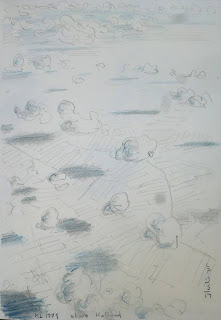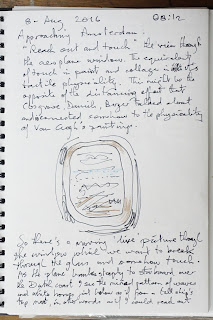Head in the clouds on Lundy.
Having your head in the clouds, as I frequently do, is its own reward but there are also rewards in sharing the addiction. I was recently invited by Gavin Prettor-Pinney, creator of The Cloud Appreciation Society (CAS), co-founder of The Idler magazine, and, most importantly, author of the indispensable The Cloud Spotter's Guide (2006) and The Wave Watchers Companion (2010), to give a talk on the cloud in art during the CAS's annual Sky Gathering, which took place this year on the island of Lundy a small but inhabited land in the Bristol Channel.
 |
| Lundy island west coast looking south |
 |
| Gavin Pretor-Pinney: photo credit Nadav Kander for The New York Times |
We gathered at a hotel in central London and took a coach trip to the Lundy ferry at Ilfracombe via Stone Henge, the famous picturesque gardens at Stourhead in Wiltshire and Barnstable all of which were new to me.
 |
| Stourhead lake and Greek temple, aquarelle pencil. |
 |
| Passing Stonehenge in a traffic jam, graphite. |
 |
| Barnstable bridge, tide ebbing, aquarelle pencil. |
The ferry, a classic 1950s design called the Oldenburg, was only one year older than me so doing pretty well despite being a heavily polluting diesel ship.
 |
| Leaving Ilfracombe on the Oldenburg: photo credit Phil Nobel for Reuters. |
 |
| The Oldenburg, built in Germany in 1958. |
Before I went to Lundy I tried to imagine what it was like:
 |
| Imaginary Lundy, aquarelle pencil |
Apart from the weather this wasn't a bad impression of the west coast. Here's what I actually saw, the weather a little calmer than expected.
 |
| The Old Lighthouse, watercolour and oil pastel |
And here are a few more watercolours which try to capture something of the amazing and complex cirrus skies and contrails we saw and the stratocumulus formations above the mainland of North Devon. With all that high altitude sunshine I managed to get my first sunburn in years.
My talk on the sky in art was one of the first in the programme, which included a presentation on the future of weather forecasting by Met Office meteorologist and TV weather presenter Helen Roberts and one on the poetry of clouds by Richard Hamblyn the best selling author of 'The Invention of Clouds' assisted in the poetry readings by the amazing folk singer Lisa Knapp.
Gavin and his sizeable team had organised a satellite webcast of the talks from St Helen's church, a massive structure for the size of the population but perfect for the audience of 80 or so people.
Despite the best efforts of the techies a simple switching on of the kettle in preparation for a break time cuppa managed to knock out all the electrics and the internet broadcast for a while. The contingencies of island life. Here's my talk, session 3 on the Sky Gathering website. I have to warn you that I had a bad throat infection and had almost totally lost my voice by the time we reached Lundy so it was a minor miracle that I was able to be heard at all by the audience or on the webcast. You can watch all 12 talks here:
After my talk I ran a couple of well attended sketching workshops where I showed a group of CAS members some techniques for quickly observing the sky and sea as it changed before our very eyes.
 |
| Lionel demonstrating sketching in aquarelle pencils |
I had brought with me about 200 coloured aquarelle pencils, 20 water reservoir brushes and 20 hard back sketch pads to give to members who took up the sketching challenge. After each workshop I encouraged everyone to continue appreciating clouds through sketching and show the results in the church on the last day alongside my Lundy watercolour paintings and the results of other workshops.
Reuters journalist Mari Saito flew in specially form Tokyo to document the events for a special report on the gathering for the Reuters website:
Her interview with me took place whilst I was painting a tricky watercolour of Cirrus and Strato cumulus over Lundy's restored medieval Marisco Castle. It was fascinating to get a young, globe trotting journalist's views on climate change and on the possible future for people and the earth's ecosystems. Her photographer Phil Noble from Manchester took some very nice photos:
 |
| Lundy's Marisco Castle: photocredit Phil Noble for Reuters |
Phil must have taken his photo after I completed the watercolour below of the same view because the cirrostratus in my painting has moved further south and the sun has moved to the west judging by the shadows on the castle.


You can see how difficult it is for photographers to capture the sense of intense light that's possible with watercolours. The distant cumulus over Dorset in Phil's image has a similar reddish purple hue that I've captured in the watercolour but even though it looks a bit garish in the painting it is truer to my experience of being there. For me painting is generally much closer to perceptions of colour, light and movement than photography and I believe this to be a fundamental difference due to the machine made aspect of photography. Even so, some paintings can look more like photos than paintings but often these look static like a frozen moment in time. The value of drawing and painting for me is that convey, as John Berger said, the act of seeing the understanding that comes from following and being with the subject over a period of time. Literally the drawing shows us not only appearances but perceptions and priorities.
In this example the painting contains physical substances, such as earth from the ground on which I was sitting, making connections with the physical world, including the weather (how quickly the paint dries), that photography rarely can. Although I have taken thousands of photographs over many decades, developing my own negatives and positives in black and white and colour before the age of digital photography, my photographs of landscape always disappoint in comparison to paintings and drawings. They often lack depth something that cannot be said of Berndnaut Smilde's beautifully composed indoor photographs.
I shared a room with Berndnaut, who travels the world 'making' clouds, and gained a real insight into his ideas, methods and artistic journey.
In this example the painting contains physical substances, such as earth from the ground on which I was sitting, making connections with the physical world, including the weather (how quickly the paint dries), that photography rarely can. Although I have taken thousands of photographs over many decades, developing my own negatives and positives in black and white and colour before the age of digital photography, my photographs of landscape always disappoint in comparison to paintings and drawings. They often lack depth something that cannot be said of Berndnaut Smilde's beautifully composed indoor photographs.
I shared a room with Berndnaut, who travels the world 'making' clouds, and gained a real insight into his ideas, methods and artistic journey.
He carries various battery packs, water vapour and cloud seeding machines to mainly indoor locations such as this church as well as museums, art galleries, castles and palaces. He made a cloud in St Helens church and one in a mine tunnel with the help of Sky Gathering guests. The clouds only last a few seconds but the work behind the published artwork is the carefully planning of light an composition. The only thing he's not fully in control of is what shape the cloud becomes. Magical images for a modern climate conscious audience.
After a fascinating and very busy three days on Lundy it was time to leave and as the ferry approached the landing stage I quickly grabbed one last chance to paint.
With a couple of extra weeks I might have been able to create some stunning landscapes of Lundy especially of the sea cliffs along the north west coast. It's a small but dramatic landscape set in wide sea with distant coastlines of Wales and England. Lundy has a slow pace of life with few artificial noise distractions so you can really hear the sounds of weather, birdlife and sheep. Come to think of it it's a bit like the North Pennines where I live but with the added attraction of the sea and cliffs. There are even a few wind blasted trees below the village in a protected gulley.
Finally we boarded the ship and bid farewell to Lundy under high altitude skies criss-crossed with the a dense contrail network of international travel.
These patterns are beautiful in one respect but a frightening reminder of the impact we are having on the planet. 21 years ago, as part of my Masters in Fine Art I made a series of contrail drawings and paintings as iconic images of the contemporary contrail sky and my experiences of air travel. I think these are just as relevant today if not more so and whenever I fly I try to get a window seat to draw the experience which may not be so readily available in a post-fossil fuel world.
 |
| Global Sky, oil, 1999-2019 |



















































